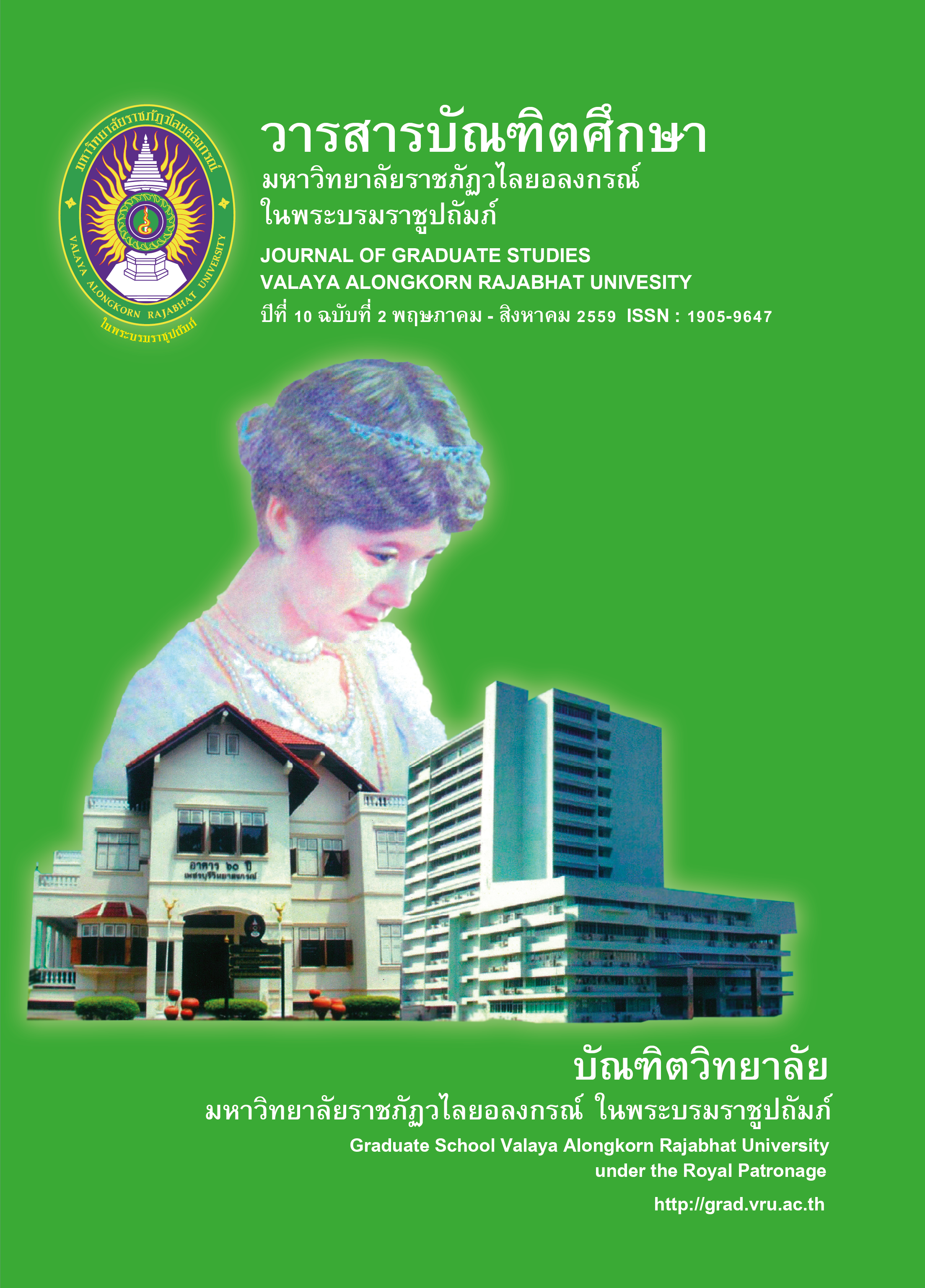ผลสัมฤทธิ์การบริหารจัดการทรัพยากรน้ำในพื้นที่ลุ่มน้ำเจ้าพระยาจังหวัดชัยนาท-กรุงเทพมหานคร
Main Article Content
Abstract
บทคัดย่อ
การวิจัยนี้ มีวัตถุประสงค์เพื่อ 1) ศึกษาผลสัมฤทธิ์การบริหารจัดการทรัพยากรน้ำในพื้นที่ลุ่มน้ำเจ้าพระยา จังหวัดชัยนาท-กรุงเทพมหานคร 2) ศึกษาปัจจัยที่ส่งผลต่อผลสัมฤทธิ์การบริหารจัดการทรัพยากรน้ำในพื้นที่ลุ่มน้ำเจ้าพระยา จังหวัดชัยนาท-กรุงเทพมหานคร และ 3) นำเสนอแนวทางการบริหารจัดการทรัพยากรน้ำในพื้นที่ลุ่มน้ำเจ้าพระยา จังหวัดชัยนาท-กรุงเทพมหานคร เป็นการวิจัยแบบผสานวิธี ประชากรในเชิงคุณภาพ ได้แก่ บุคคลที่เป็นผู้มีบทบาทสำคัญในการกำหนดนโยบายและการขับเคลื่อนนโยบายการบริหารจัดการน้ำในลุ่มน้ำเจ้าพระยา รวม 35 คน ใช้การสัมภาษณ์เจาะลึก ประชากรในเชิงปริมาณ ได้แก่ ประชากรที่อาศัยอยู่บริเวณลุ่มน้ำเจ้าพระยาและได้รับผลกระทบจากน้ำเจ้าพระยาใน 7 จังหวัด จำนวน 39,943 คน ได้กลุ่มตัวอย่าง จำนวน 328 คน โดยการเปิดตารางของ Krejcie & Morgan สุ่มตัวอย่างแบบแบ่งชั้นภูมิ และการสุ่มแบบง่าย เครื่องมือการวิจัย ได้แก่ แบบสัมภาษณ์เจาะลึก และแบบสอบถาม วิเคราะห์ข้อมูลเชิงคุณภาพด้วยวิธีอุปนัย และใช้สถิติขั้นพื้นฐานวิเคราะห์ข้อมูลเชิงปริมาณ ได้แก่ การแจกแจงความถี่ ค่าร้อยละ ค่าเฉลี่ย และส่วนเบี่ยงเบนมาตรฐาน
ผลการวิจัยพบว่า
1. ผลสัมฤทธิ์การบริหารจัดการทรัพยากรน้ำในพื้นที่ลุ่มน้ำเจ้าพระยา จังหวัดชัยนาท- กรุงเทพมหานคร โดยภาพรวมอยู่ในระดับมาก เมื่อพิจารณาเป็นรายด้านการปรับปรุงสิ่งก่อสร้างที่มีอยู่เดิมอยู่ในระดับที่สุด ทั้งนี้เพราะการปรับปรุงสิ่งก่อสร้างที่มีอยู่เดิม เป็นภารกิจสำคัญของหน่วยงานภาครัฐที่ดำเนินการอย่างต่อเนื่องและค่อนข้างจะเห็นเป็นรูปธรรมมากกว่าด้านอื่น
2. ปัจจัยด้านเครือข่ายร่วม ส่งผลต่อผลสัมฤทธิ์การบริหารจัดการทรัพยากรน้ำในพื้นที่ลุ่มน้ำเจ้าพระยา จังหวัดชัยนาท-กรุงเทพมหานคร มากกว่าปัจจัยตัวอื่นอย่างมีนัยสำคัญ
3. แนวทางการบริหารจัดการน้ำในพื้นที่ลุ่มน้ำเจ้าพระยา จังหวัดชัยนาท-กรุงเทพมหานคร เริ่มจากการกำหนดนโยบายภาครัฐให้ครอบคลุมกับสภาพปัญหาในพื้นที่ลุ่มน้ำตอนกลางทั้งหมด และการจัดทำแผนแม่บทที่อยู่บนพื้นฐานของสภาพปัญหาที่แท้จริง ตลอดถึงการนำนโยบายไปปฏิบัติที่คำนึงถึงภูมิสังคมของแต่ละพื้นที่ นอกจากนี้ ยังต้องพิจารณาการปรับปรุงองค์กรที่เกี่ยวกับน้ำ การปลูกจิตสำนึก การเตรียมความพร้อมในการอพยพ และการสร้างความพร้อมให้กับหน่วยงานท้องถิ่น
ABSTRACT
The research was the purpose to study 1) the achievement of water resource management in the Chao Phraya River Basin, Chai Nat-Bangkok 2) the factors affected the achievement of management of water resources in the Chao Phraya River Basin Chai Nat-Bangkok and 3) to provide guidelines for the management of water resources in the Chao Phraya, Chai Nat-Bangkok. The combine methodology research was used. The 35 people were population and using interviews, including the person who played a key role in policies making and policies implementation in the Chao Phraya River. The quantitative population of 328 samples was obtained using Krejcie and Morgan’s table of Stratified Sampling and Simple Random Sampling to determine the sample size from 39,943 people lives in Chao Phraya Basin and affected by the Chao Phraya River in the seven provinces. The research methodologies employed were in-depth interview and questionnaires. Analytic Induction was utilized for data analysis of the qualitative population, while basic statistics analysis, namely frequency, percentage, mean, and standard deviation were used for quantitative population data analysis.
The research found that
1. Achievement of water resources management in the Chao Phraya River Basin, Chai Nat-Bangkok at the high. Considered of each aspects found that the renovation of an existing building at the most high, because of improvements to existing buildings was the important task of the government agencies operated continuously and would rather see a more substantial side.
2. Factors of the common network affecting the achievement of water resources Management in Chao Phraya River Basin, Chai Nat-Bangkok affected more than any other factors significantly.
3. A guideline for the management of water in the Chao Phraya River Basin, Chai Nat-Bangkok is to start from public policies making to covers all of central watershed problem. The master plan was based on the real problems. The master plan was based on the real problems throughout the implementation considering the social landscapes of the area also had to consider organizational improvements on the water. Making awareness and preparing to evacuate including to prepare the readiness of local agency were operated.
Article Details
บทความทุกเรื่องได้รับการตรวจความถูกต้องทางวิชาการโดยผู้ทรงคุณวุฒิ ทรรศนะและข้อคิดเห็นในบทความวารสารบัณฑิตศึกษา มหาวิทยาลัยราชภัฏวไลยอลงกรณ์ ในพระบรมราชูปถัมภ์ มิใช่เป็นทรรศนะและความคิดของผู้จัดทำจึงมิใช่ความรับผิดชอบของบัณฑิตวิทยาลัย มหาวิทยาลัยราชภัฏวไลยอลงกรณ์ ในพระบรมราชูปถัมภ์ กองบรรณาธิการไม่สงวนสิทธิ์การคัดลอก แต่ให้อ้างอิงแหล่งที่มา


